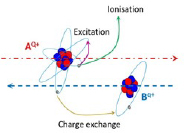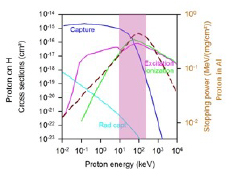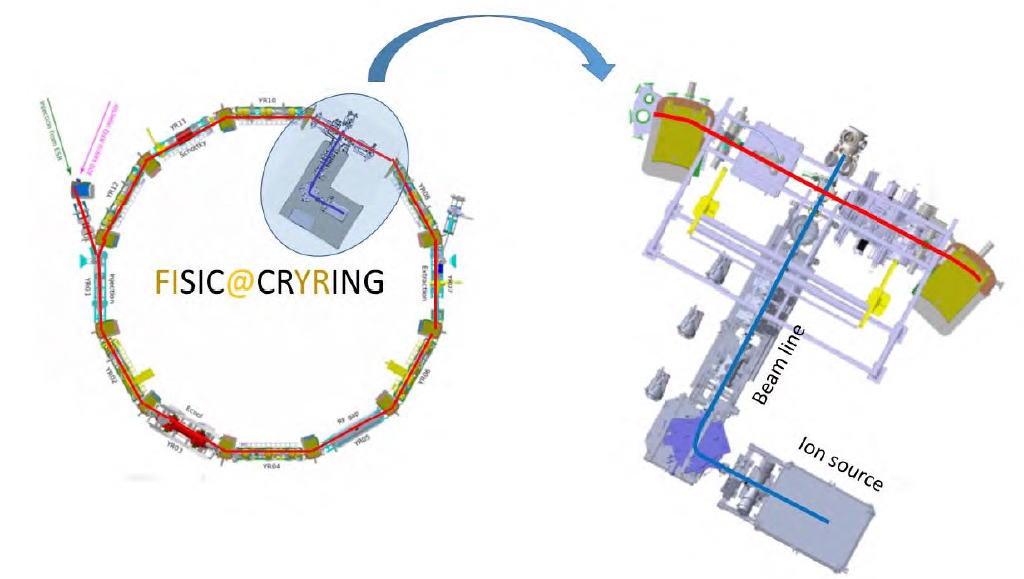Team
- Permanent members: Emily Lamour, Christophe Prigent, Martino Trassinelli, Sébastien Steydli, Stéphane Macé, Dominique Vernhet
- PhD Student : Mariette Joly (2021-2024)
Ion–ion collisions provide a unique scenario for testing our knowledge of fundamental electronic processes such as capture, ionization and excitation (Figure 1a). Their study is also motivated by the fact that they are strongly correlated to the ion energy transfer in matter, whether this matter is in neutral solid or plasma-like form.
Whereas ion–ion experiments for high-energy physics (like the experiments at CERN) are currently carried out, ion–ion collisions for atomic physics have been so far performed mainly in the context of magnetically confined plasmas, i.e. in the low‐energy domain (typically at center-of-mass energies a few 100 keV) where the charge transfer is by far the dominant process i.e. the capture process in blue in Figure 1a.
On the contrary, measurements and reliable theoretical predictions are completely lacking for fast ion‐slow ion collisions with from 1 to a few tens of MeV/u, a regime in which the ion stopping power is maximum (the pink area in Figure 1b). There, the strongest effects on material modifications including biological material are observed. This regime is characterized by the fact that all the primary electronic processes have probabilities of the same order of magnitude. This gives rise to “interference effects” that must be taken into account in theoretical treatment. This circumstance leads to the paradox situation where, for this velocity regime, cross sections are very tough to predict while their knowledge is of crucial importance for the understanding of energy transfers in matter.
 |
 |
| Figure 1.a: Possible electronic processes when a AQ+ ion interacts with a Bq+ ion.
|
Figure 1.b: Cross sections of elementary atomic collision processes for the system p® H. The pink area corresponds to the intermediate velocity regime. The brown line is the stopping power (refer to the right y‐axis) for protons in solid aluminium. |
In this context, the ASUR team leads an international collaboration, named FISIC (Fast Ion – Slow Ion Collisions) involving experimentalists and theoreticians ( 35 persons from France, Germany, Austria and Argentina). The objectives of the FISIC project are to explore the role of electrons bounded to the ion projectile (the fast ion) and/or to the ion target (the slow ion) -one by one- so as to quantify several effects such as electron-electron interactions, the importance of the multi-electron processes and the role of Coulomb forces acting on the electron cloud in the entrance and exit pathway of the collision. Hence, studies for a wide range of projectile ‐ target combinations should provide original data on quantum dynamics of N-body systems. Performing ion-ion experiments for absolute cross section measurements remain a real challenge involving several steps that have to be solved such as the charge state control of both ion beams, the control of the overlap between the two ion beams, the design of the collider chamber, the ultra-high vacuum conditions (10-11 mbar), the detection of the product ions on the high-energy channel as well as on the low-energy one and a fast acquisition system for coincidence measurements. The avenue of new-generation ion accelerators under construction such as GANIL/SPIRAL2/S3 (France) and FAIR/GSI/CRYRING (Germany) will open real opportunities towards the study of the intermediate collision regime by providing MeV energy and intense ion beams of high optical quality. Meanwhile, our teams with collaborators are developing a unique experimental crossed-beam arrangement. More precisely, a low-energy platform that will deliver intense slow ions beams will be connected to the accelerator through a chamber where ion-ion collisions will take place (See Figure 2 that illustrates the installation at CRYRING as an example). This low-energy FISIC platform is divided into two parts. The first one, upstream the collision zone, is equipped with an ion source connected to a beam transport line well-adapted to shape the beam and clean it from the non-desired charge state (Renvoi vers la page Equipements/Purificateur). This beam line is already mounted at the SIMPA facility (Renvoi vers la page Equipements/Ligne basse énergie FISIC) and the ion source is expected to be delivered in 2021.

Figure 2:The FISIC set-up on the CRYRING ion storage ring at GSI. A zoom shows the low-energy platform equipped with an ion source and a dedicated beam line.
Collaborations
Main persons/Laboratories involved in the experimental development of the FISIC project : the team ASUR at INSP (SU PARIS) and D Schury , A Mery, J Rangama and the team AMA at CiMAP (Caen), H Savajols, C Stodel, R Levallois and the GANIL (Caen), A Drouart, Irfu (Palaiseau), A Gumberidze, A Braeuning-Demian, T Stoehlker, Lestinsky, M Lestinsky et alfrom GSI at Darmstadt and iOQ at Jena (Germany), S Schippers from Justus-Liebig-University Giessen (Germany).

